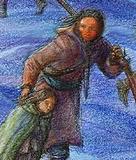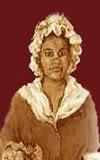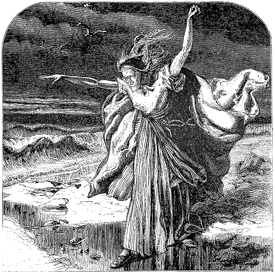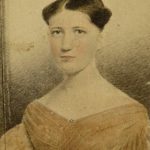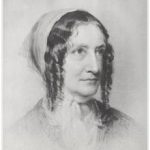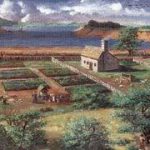Captured at the Deerfield Massacre
Image: Depiction of Eunice Being Led Away from Deerfield
Eunice’s captor hurried her toward the north gate
Illustration copyright Francis Back
Eunice Williams was born in Deerfield, Massachusetts, on September 17, 1696, the daughter of Puritan minister the Reverend John Williams and his wife Eunice Mather Williams. The girl who would grow up to become the most famous “unredeemed captive” had a conventional New England Puritan upbringing until the age of seven. Her family’s wealth and prominence made her early life a bit more privileged than that of other young Deerfield girls, and her fate as an adopted Kanienkehaka (Mohawk) better known.
On February 29, 1704, in the pre-dawn hours, a force of about 300 French and Native allies launched a daring raid on the English settlement of Deerfield, Massachusetts, that became known as the Deerfield Massacre.
The Williams home was attacked and Eunice’s six-week-old sister, Jerusha, and younger brother, John, Jr., were killed by hatchet. Eunice, her parents, and four of her siblings were taken captive. On the second day of captivity Eunice’s mother, weak from recent childbirth, was slain while attempting to cross the icy waters of the Green River.
Carried on the shoulders of her captor as they traveled through deeper snow and climbed into the hills, Eunice was numb — almost too cold and hungry to be afraid of what might happen next. After camping one night with the remaining group of Deerfield captives, the Indians conferred, and her captor set off with her and a few of his fellows. There were no longer any English adults for Eunice to look to for help or counsel, no one who could even understand her words.
After several days in which none of them had more than a handful of dried corn to eat, Eunice was left in a temporary wigwam while the men tracked a small deer herd. They shot a buck and a doe, and Eunice thought she had never tasted any victuals as sweet as the roasted meat she was given that day.
In all, 112 Deerfield men, women, and children were captured and taken on a 300-mile forced march to Canada in harsh winter conditions. Eunice and the surviving members of her family reached Fort Chambly in Quebec six weeks later.
From the French fort, Eunice and her captors traveled west until they came to another river, and saw a large town in the distance: Kahnawake, a settlement of Christian Mohawks near Montreal. They had arrived at their destination.
Eunice had never seen such a place. Kahnawake was two to three times bigger than Deerfield, a veritable city of longhouses, more than she could easily count. It stretched out along the banks of a turbulent river. Beyond the longhouses Eunice could see a church steeple and other buildings. As they approached the town, many people ran to greet them—men, women and children all shouting and talking and crowding around them.
Outside one of the longhouses, they were greeted by a woman with tears in her eyes. The woman gathered up Eunice and carried her through the bark door of the longhouse. The woman and several others told Eunice that it was time for her to be formally adopted. They took her to a great washtub and plunged her in and scrubbed her clean.
Then they gave her new leggings decorated with ribbons and a beautiful pair of beaded deerskin moccasins, a clean English linen shirt, and a red wool blanket as a cloak. They braided her hair and put a length of wampum around her neck, and led her to a feast at the council house.
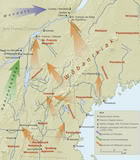
Image: Native Homelands and Movements, circa 1650 – 1750
This map shows the traditional homelands of the Native groups involved in the Raid of 1704, and the locations of the communities they moved to after being displaced by other Native and Colonial groups. Sources: Captors and Captives: The 1704 French and Indian Raid on Deerfield, by Evan Haefeli and Kevin Sweeney, 2003
Eunice Becomes Waongote
After everyone had eaten, an elder rose and spoke. An English woman who had been at Kahnawake for a long time translated for Eunice. “Now you are Waongote. You are flesh of our flesh and bone of our bone. By the ceremony that was performed today, every drop of white blood is washed from your veins and you are one of us by an old, strong law and custom. You are taken into the Kanienkehaka (Mohawk) Nation and into a great family, in the place of a beloved child. My daughter, you now have nothing to fear, for we will love, support, and defend you as we do each other.”
Eunice still tried to pray and recite the Puritan catechism every day, as her parents had taught her. After her second week at Kahnawake, however, she was taken to see the Jesuit, who taught her prayers in Latin and told her about the saintly Macqua woman, Kateri Tekakwitha, whom she should emulate. Eunice was troubled; would these new prayers help save her soul or imperil it?
As soon as the residents of Deerfield learned that their captured relatives were being held in Quebec, they began negotiations to pay a ransom for their safe return. During these months, Reverend Williams was allowed to meet with Eunice on two occasions; when she asked him for guidance, he told her to frequently recite the Puritan Catechism.
When the Reverend’s freedom was finally arranged, he asked to have Eunice reunited with him, but was told that this was impossible because the Mohawk people with whom she was living “would as soon part with their hearts as the child.” Some of the Deerfield captives were later redeemed and returned home, but one-third chose to remain among their French and Native captors.
Eunice didn’t notice when she stopped thinking of herself as Eunice, or when she stopped speaking and thinking in English. In her new clothing, she felt freer to move, and stronger. She could run as fast as the other Kahnawake girls. She could take her turn at the pounding the corn for the day’s meal.
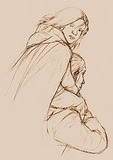
Image: Eunice Williams
After her adoption by the Kanienkehaka
Illustration copyright Francis Back
Sometimes Englishmen came to speak to Waongote. Their words sounded familiar, but she couldn’t understand their sense. When their meaning was translated to her, it was always the same: did she want to go back to Deerfield and the Reverend John Williams? She could hardly remember anything about that life. She would hide her face and shake her head. No, she couldn’t change herself again.
Waongote was a serious and reverent girl. As she grew older, she spent a lot of time with Akso, Grandmother, and studied the Catholic religion with her grandmother and with the Bear clan dogique – one who presides over public prayers. She was more comfortable with him than with the Jesuits. When she was baptized she was given a new name, and was thereafter known by two names – her Christian name, Marguerite, and her Mohawk name, Waongote.
Marguerite Waongote was becoming a young woman. She took on the responsibilities of an adult: planting, cultivating, and harvesting the corn, squash, and beans; collecting firewood; preparing food; making clothing. She attended Mass several times a week. During hunting season, she accompanied hunting parties to their camp, where she helped to prepare the deer they killed.
To reflect her growing responsibilities in the community, it was time for Marguerite Waongote to take an adult name. Her grandmother and mother, both Bear clan matrons, consulted about an appropriate clan name that was not already in use.
They determined that she should be called Kanenstenhawi, she brings in corn, expressing a woman’s most sacred and solemn responsibility. She took her new name at a naming ceremony that was part of the Midwinter Festival. Now she was Marguerite Kanenstenhawi, as she would remain for the rest of her life.
Francois Xavier Arosen, a man whom Kanenstenhawi had met on a trip to the Mohawk Valley, came to Kahnawake and proposed breaking with the French and making an alliance with the English, who were planning to attack the leading French settlement at nearby Montreal. The plan failed, and Arosen went back to the south, but Kanenstenhawi’s mother and grandmother pointed him out to her as a brave warrior, and noted that they knew his family to be a good one.
Arosen soon returned to Kahnawake, and stayed in the longhouse of his Wolf clan relatives. He had already adopted Catholicism, taking François Xavier as his Christian name, so the village was congenial to him. In time, the matrons of his relatives’ longhouse approached Kanenstenhawi’s mother and grandmother. They all agreed that a match between Kanenstenhawi and Arosen would be appropriate, and they were married in 1713.
That spring, an emissary from the English came to Kahnawake. Marguerite Kanenstenhawi and Arosen were summoned to the priest’s residence, and she was pressured to return to her English family. The Englishman spoke at length about her father and his family’s longing to see her, and her duty as a Christian to return.
Kanenstenhawi said nothing in response. She couldn’t trust herself to speak, with all the conflicting emotions that arose in her. She was angry and offended with what he said, but at the same time she felt sorrow, and a cold fear that she would be taken against her will.
Marguerite Kanenstenhawi Williams’ birth family never stopped longing for her return; they continued attempts to compel it through official channels, and urged her to reconsider her decision every time they had contact with her. Reverend John Williams died in 1729.
Visits to Massachusetts
Finally, in August of 1740, Stephen Williams was summoned to Albany to meet with his sister. Stephen and his brother Eleazer and brother-in-law Joseph Meacham traveled to Albany, and had the “joyful, sorrowful meeting of our poor sister that we had been separated from for above 36 years.”
Arosen and Kanenstenhawi accompanied her brothers back to Stephen’s home in Longmeadow, Massachusetts, and stayed there for about a week. Arosen and Kanenstenhawi left with promises that, now that the way was open, they would return for a longer visit. They did return three more times, in 1741, 1743, and 1761.
Kanenstenhawi’s final visit to New England came in 1761, when she was 64. As in previous visits, the Williams family gathered at Longmeadow from various points in Massachusetts and Connecticut, and neighbors flocked to the church to see the returned captive. Stephen agonized over his attempts to convince his sister’s family to stay in Massachusetts, and yet again they said “they [were] not at all disposed to come and settle in the country.”
From time to time in the years after the last visit, Stephen heard news about his sister. He heard that her husband, Arosen, died in 1765.
It is uncertain how many children Marguerite Kanenstenhawi bore. Mission baptismal records prior to 1735 were destroyed by fire; surviving records show the births and baptisms of two daughters, who lived with Kanenstenhawi until her old age.
Marguerite Kanenstenhawi / Eunice Williams died on November 26, 1785 (aged 89) at her home at Kahnawake, Quebec, Canada.
SOURCE
Eunice Kanenstenhawi Williams
